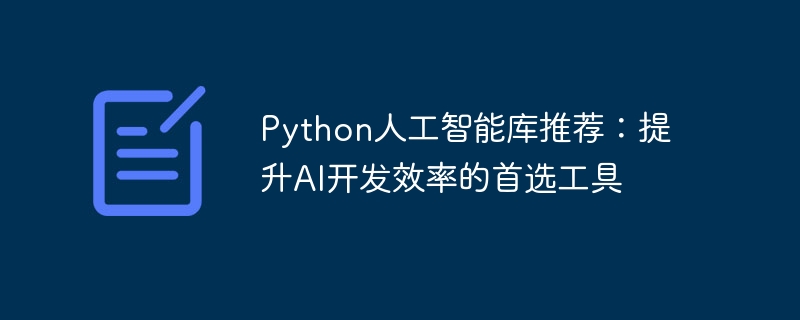

Python Artificial Intelligence Library Recommendation: The preferred tool to improve AI development efficiency
Introduction:
With the rapid development of artificial intelligence technology, more and more Developers are beginning to pay attention to and use Python to develop AI projects. However, to develop artificial intelligence in Python, in addition to the basic knowledge of Python, you also need to master some related artificial intelligence libraries. In this article, I will recommend some of the most popular and widely used artificial intelligence libraries in Python, and provide some specific code examples to help readers get started quickly.
import tensorflow as tf
from tensorflow import keras
# 导入数据集
(x_train, y_train), (x_test, y_test) = keras.datasets.mnist.load_data()
# 构建模型
model = keras.Sequential([
keras.layers.Flatten(input_shape=(28, 28)),
keras.layers.Dense(128, activation='relu'),
keras.layers.Dense(10, activation='softmax')
])
# 编译和训练模型
model.compile(optimizer='adam', loss='sparse_categorical_crossentropy', metrics=['accuracy'])
model.fit(x_train, y_train, epochs=5)
# 评估模型
test_loss, test_acc = model.evaluate(x_test, y_test)
print('Test accuracy:', test_acc)import torch
import torch.nn as nn
import torch.optim as optim
# 定义模型
class LSTM(nn.Module):
def __init__(self, input_size, hidden_size, num_layers, output_size):
super(LSTM, self).__init__()
self.hidden_size = hidden_size
self.num_layers = num_layers
self.lstm = nn.LSTM(input_size, hidden_size, num_layers, batch_first=True)
self.fc = nn.Linear(hidden_size, output_size)
def forward(self, x):
h0 = torch.zeros(self.num_layers, x.size(0), self.hidden_size).to(device)
c0 = torch.zeros(self.num_layers, x.size(0), self.hidden_size).to(device)
out, _ = self.lstm(x, (h0, c0))
out = self.fc(out[:, -1, :])
return out
# 导入数据集
train_dataset = ...
train_loader = torch.utils.data.DataLoader(train_dataset, batch_size=64, shuffle=True)
# 构建模型
device = torch.device('cuda' if torch.cuda.is_available() else 'cpu')
model = LSTM(input_size, hidden_size, num_layers, output_size).to(device)
# 定义损失函数和优化器
criterion = nn.CrossEntropyLoss()
optimizer = optim.Adam(model.parameters(), lr=learning_rate)
# 训练模型
total_step = len(train_loader)
for epoch in range(num_epochs):
for i, (sequences, labels) in enumerate(train_loader):
sequences = sequences.to(device)
labels = labels.to(device)
# 前向传播和反向传播
outputs = model(sequences)
loss = criterion(outputs, labels)
optimizer.zero_grad()
loss.backward()
optimizer.step()
if (i + 1) % 100 == 0:
print('Epoch [{}/{}], Step [{}/{}], Loss: {:.4f}'
.format(epoch + 1, num_epochs, i + 1, total_step, loss.item()))from sklearn import datasets
from sklearn.model_selection import train_test_split
from sklearn.neighbors import KNeighborsClassifier
from sklearn.metrics import accuracy_score
# 导入数据集
iris = datasets.load_iris()
X = iris.data
y = iris.target
# 数据集划分
X_train, X_test, y_train, y_test = train_test_split(X, y, test_size=0.2, random_state=42)
# 构建模型
knn = KNeighborsClassifier(n_neighbors=3)
# 模型训练
knn.fit(X_train, y_train)
# 模型预测
y_pred = knn.predict(X_test)
# 模型评估
accuracy = accuracy_score(y_test, y_pred)
print('Accuracy:', accuracy)Conclusion:
This article recommends three of the most popular and widely used artificial intelligence libraries in Python: TensorFlow, PyTorch and scikit-learn, with specific code examples for each library. Mastering these libraries will greatly improve the efficiency of AI development and help developers realize various artificial intelligence tasks faster. I hope this article can be helpful to readers in Python artificial intelligence development.
The above is the detailed content of Recommended artificial intelligence development library: the preferred tool to improve AI development efficiency. For more information, please follow other related articles on the PHP Chinese website!




